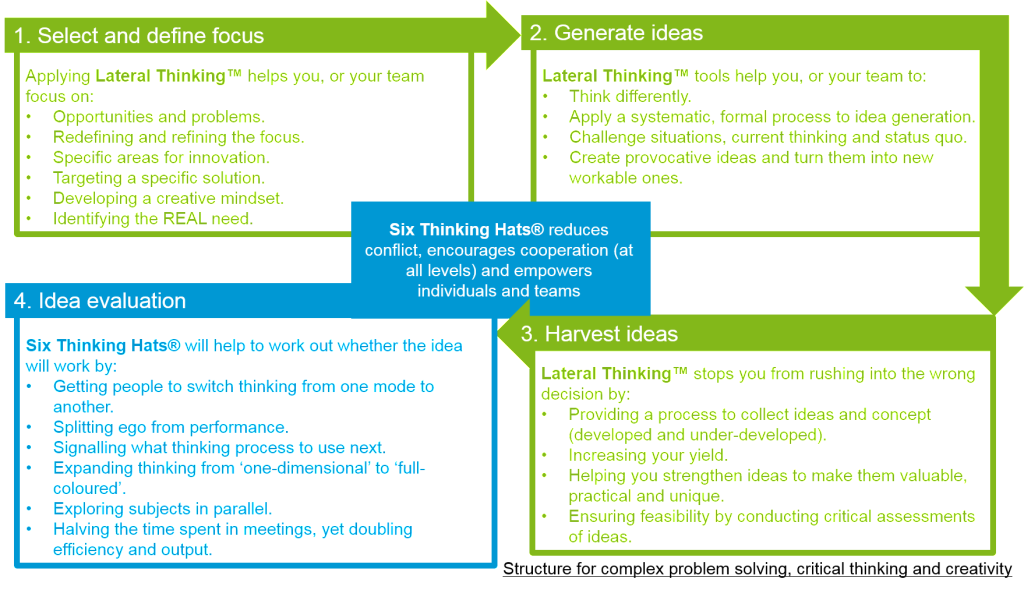Our article ‘Is innovation a part of your culture?’ looks at how many organisations want to be innovative or creative, yet the people at the top of the organisation cannot often elaborate on how or if this happens. In this article we will look at the importance of ideas, how to generate them and some recommended thinking techniques.
Forrester Consulting (2014) found that organisations who embrace creativity gain competitive advantage through:
- Positive revenue improvement.
- Increased market share.
- Easier talent acquisition and retention.
- An ever-evolving high-performance working environment, driven by leaders and managers who provide processes, methods and funding.
Everyone within an organisation has the potential to provide solutions to a problem; ideas for a new product; or foresee a potential challenge on the horizon. It is up to the organisation to ensure that they feel able and are equipped with the skills, to generate and communicate these ideas. The ability to generate ideas on-demand in your organisation means:
Employees are –
- More satisfied (through being allowed to be creative and listened to).
- Less stressed and more productive (improved problem-solving skills).
- Being a part of improving what they do (less stress and conflict).
- Learning a new skill that can be used with their team and throughout the organisation (feeling invested in and improved morale).
Management get –
- Tools, for them and their team members, for meetings and idea sessions that provide positive consensus and reduced conflict (saving time and improving morale).
- The capability to be more objective when setting and reviewing strategies (high-performance working environment).
- The ability to understand, fix and foresee impossible issues (efficient problem solving).
- Improved processes, time and cost efficiency (what’s normal now, gets better).
Customers appreciate –
- Better service and experience (improved customer feedback and retention).
- Enriched products and services (a better brand).
- Less problems or problems dealt with more effectively (satisfied customers).
Why ideas?
You might think innovation is just a buzz word or that your organisation is ok where it is and it doesn’t need to move forward. It is important to understand that without new ideas your organisation and people will stagnate. The most successful organisations have already realised that they require different ideas so that they can survive and innovate. These ideas are not always revolutionary but are improvements to what they are doing already, so they become more time, resource and cost efficient.
Why lots of ideas?
The more ideas you generate the more likely you are to find that golden nugget. We train you to group your ideas and drill down to get to ideas that you can action rather than high-level concepts.
“Lateral Thinking is for changing concepts and perceptions instead of trying harder with the same concepts and perceptions.” Lateral Thinking formal definition from Dr Edward de Bono
When we deliver Edward de Bono’s Lateral Thinking we ask attendees where they come up with their best ideas. 90-95% of people do not say “at work”. Most say they come up with their best ideas during their personal time (the shower, the loo, on holiday, out exercising). That is quality thinking outside of working hours; not in the workplace and away from colleagues. Not that helpful when you need to get ideas in the work environment. They all agree they need the techniques and process to be able to generate ideas on-demand.
Where can it go wrong?
Ingredients – a challenge, meeting room, people, flip chart and pens (maybe some Post-It’s).
Method – throw together and brainstorm.
Result – same old.
You will often find that the same particular group of ‘experts’ are there every time, often with their own agendas, resulting in lack of buy-in from the rest of the organisation. This is because the need for the ideas are not filtering up and down the organisation, a cross section of people often works best – with and without intricate knowledge of the challenge.
‘Experts’ often get bogged down by not having a fresh perspective. The same people all the time more than likely have no structure, lack of focus, lots of disruptive influences and behaviours, a refusal to agree and nothing new to add! They will also often need a meeting about that meeting. You will often find that the ideas cannot be put into practice and if they are, they often fail.
Saving time and money by moving away from random idea sharing.
Move away from unstructured brainstorming by adding structured tools to your inspiration and imagination, so you will solve problems by looking at them from unexpected perspectives.
Edward de Bono’s Lateral Thinking involves discarding the obvious, leaving behind traditional modes of thought and throwing away preconceptions. Our practical Lateral Thinking™ workshop helps everyone involved to be creative and think outside of the box by developing a working understanding of a creative process that:
- Identifies a problem, challenge or opportunity; defines and redefines the focus.
- Provides the tools to generate a range of ideas and concepts.
- Harvests ideas; refined for usability and assessed against unique criteria.
- Delivers new concepts and ideas that can be taken forward.
With the right process and skills everyone can be creative, no matter what age or role. To be truly innovative, and make creativity a part of your culture, the whole organisation needs to be able to buy into it, use it and understand it.



